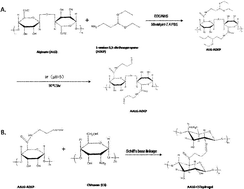BMSCs laden injectable amino-diethoxypropane modified alginate-chitosan hydrogel for hyaline cartilage reconstruction
Abstract
We developed an injectable hydrogel composed of amino-diethoxypropane modified alginate and chitosan, and also investigated bone marrow mesenchy + mal stromal cells (BMSCs) laden hydrogel for cartilage reconstruction in vitro and in vivo. Different from the traditional oxidizing method, we first introduced an amino-diethoxypropane to the alginate and formed hemiacetal group on it. The hydrogel was formed when the modified alginate met with chitosan. We characterized the chemical and rheological properties of the hydrogel and investigated the growth of BMSC in hydrogel. Then, we used real-time qPCR to in vitro quantify the relative mRNA expressions of aggrecan, SOX9 and collagen II at 1, 2, 3 and 4 weeks, and found that these genes significantly presented higher expression in Group IV (BMSCs seeded in hydrogel in chondrogenic culture medium) than in BMSCs seeded in hydrogel in routine medium group (Group II) or BMSCs in chondrogenic culture medium group (Group III). For further testing, we implanted BMSCs laden hydrogel to a rabbit knee cartilage defect model. After 12 weeks, the BMSCs laden hydrogel group presented a better repair than other groups in gross appearance using ICRS histological grading system. The level of glycosaminoglycans (GAGs) was measured, and the result showed 4.9-fold higher level of glycosaminoglycans in BMSCs laden hydrogel treated group than in the defect group. The result of real-time qPCR showed that the gene expression of aggrecan (5.8-fold), type II collagen (9-fold), proteoglycans (5.3-fold), and SOX9 (17.9-fold) were significantly higher in the BMSCs loaded hydrogel treated group than in defect group, but the type I collagen gene expression was lower (4.9-fold) in BMSCs loaded hydrogel treated group than in defect group. In the histology analysis of HE, Alcian blue, Toluidine blue, and Masson's trichrome staining, the results showed that the BMSCs laden hydrogel treated group formed more chondrocytes, proteoglycans, and glycosaminoglycans (GAGs) than in the hydrogel treated group or defect group. Overall, our study showed that the developed injectable hydrogel can be loaded with BMSCs, and it can promote cartilage regeneration.


 Please wait while we load your content...
Please wait while we load your content...